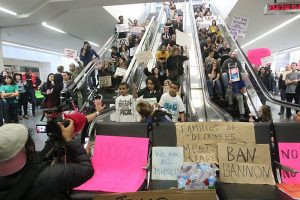On January 27, 2017, a week into his presidency, Donald Trump signed an executive order that quickly became known as the “Muslim Travel Ban”. This order dramatically restricted entry into the United States for nationals from seven predominantly Muslim countries. The initial countries listed were Iran, Iraq, Libya, Somalia, Sudan, Syria, and Yemen, and the order also suspended the U.S. Refugee Admissions Program for 120 days and all refugee resettlement from Syria indefinitely. This action immediately sparked widespread confusion and protests across the United States, particularly at international airports.
 Protest at San Francisco Airport against the Muslim travel ban in 2017, with demonstrators holding signs.
Protest at San Francisco Airport against the Muslim travel ban in 2017, with demonstrators holding signs.
The executive order triggered mass demonstrations as people gathered to voice their opposition to what they saw as religious discrimination. Immigrant rights organizations, refugee resettlement agencies, and civil liberties groups swiftly launched numerous legal challenges. These legal actions argued that the travel ban was unconstitutional, specifically citing religious bias as the primary motivation behind the policy.
The legal challenges resulted in a series of court injunctions that temporarily blocked the implementation of the initial travel ban. The Trump administration subsequently issued a revised version of the executive order, attempting to address the legal concerns raised by the courts. However, this second iteration also faced legal roadblocks and opposition.
Despite ongoing legal battles and public outcry, the Trump administration persisted in its efforts to enact a travel ban. Ultimately, a third version of the executive order reached the Supreme Court. On June 26, 2018, the Supreme Court, in a narrow 5-4 decision, upheld the third version of the travel ban, allowing it to go into effect. This version expanded the restrictions to include nationals from North Korea and Venezuela, although the Venezuelan restrictions were limited to government officials and their families.
In 2020, the Trump administration further broadened the scope of travel restrictions, adding six more countries to the list: Eritrea, Kyrgyzstan, Myanmar, Nigeria, Sudan, and Tanzania. These expansions were officially justified by citing national security concerns and alleged inadequacies in the screening and vetting processes of these nations.
As a result of these一系列 of executive actions and proclamations, nationals from a total of thirteen countries faced varying degrees of travel restrictions to the United States. The “muslim travel ban”, though officially framed as a measure to enhance national security, remained a highly controversial policy throughout its implementation and sparked significant debate about immigration, religious freedom, and presidential power.
Source
Presidential Proclamation Enhancing Vetting Capabilities and Processes for Detecting Attempted Entry Into the United States by Terrorists or Other Public-Safety Threats
Issued on: September 24, 2017

